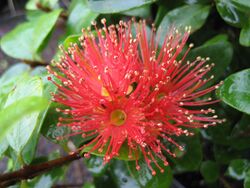Biology:Metrosideros fulgens
| Metrosideros fulgens | |
|---|---|

| |
| Metrosideros fulgens produces brilliant red flowers in winter | |
| Scientific classification | |
| Kingdom: | Plantae |
| Clade: | Tracheophytes |
| Clade: | Angiosperms |
| Clade: | Eudicots |
| Clade: | Rosids |
| Order: | Myrtales |
| Family: | Myrtaceae |
| Genus: | Metrosideros |
| Species: | M. fulgens
|
| Binomial name | |
| Metrosideros fulgens Sol. ex Gaertn.
| |
| Synonyms | |
|
Metrosideros scandens | |
Metrosideros fulgens (scarlet rātā, rātā vine[1] or in Māori akatawhiwhi[2]) is a forest liana or vine endemic to New Zealand. It occurs in coastal and lowland forest throughout the North Island, on the west coast of the South Island and on the Three Kings Islands north of Cape Reinga. It is one of a number of New Zealand Metrosideros species which live out their lives as vines, unlike the northern rata (M.robusta), which generally begins as a hemi-epiphyte and grows into a huge tree. Scarlet rātā is one of the better-known species of rātā vines, because it flowers in autumn or winter, and is often highly visible on well-lit host trees along forest roads, with vibrant displays of large red flowers (sometimes orange or yellow) that rise above the forest canopy.
Description
Metrosideros fulgens prefers warm moist habitats and grows up to 10m long or more, with the main stem up to 10 cm or more in diameter. It climbs in the same way as ivy, sending out short adventitious roots to adhere to the trunks of host trees, penetrating and clinging to rough surfaces. The climbing shoots of juvenile plants are designed to grow rapidly and extend the length of the plant. The short clinging roots usually die after about a year, so that when the vine is mature, the thick, twisted, rope-like stems hang free from the host like thick, sometimes twisted ropes, with red-brown flaky bark. The leaves are mostly rounded at the tip. Flowering is from autumn to spring, with seed capsules taking about a year to ripen.
Cultivation
There are several cultivars of M. fulgens available, mostly selected for their flower colours.
- Metrosideros fulgens ‘Gold’/'Aurata' has bright yellow flowers from late summer to early winter and grows to 1.5 by 1.5 metres, taking several years to reach this size. It has attractive fresh light green foliage, and can be trimmed to form an informal hedge. M. Aurata was first encountered in 1890 near Collingwood by a Mrs S. Featon of Gisborne, and was first thought to be a separate species (Metrosideros aurata).[3][4] M. Gold was the name used when introduced into cultivation, and was sourced in the same area and time as M. Jaffa below.
- Metrosideros fulgens 'Jaffa' is a compact bush producing brilliant burnt-orange flowers. This cultivar was selected in the mid-1990s from a specimen growing on the Tairua-Whitianga Road in the Coromandel Peninsula by Jenny Oliphant. It has been available since 2001.[4]
- Metrosideros fulgens 'Orange Princess' was released in 2000 by Duncan & Davies in Taranaki. This cultivar was sourced from the Onaero River valley.[4] Its appearance is very similar to M. Jaffa.
- Metrosideros fulgens 'Red Glow' is a more "standard" form of M. fulgens and has orangy-red flowers. The source of this cultivar is not known but has only been available for a few years.
In addition to the above cultivars, it is also possible to by regular forms of M. fulgens through specialist plant nurseries.
See also
References
- ↑ "Māori Plant Uses Database". http://maoriplantuse.landcareresearch.co.nz/WebForms/PeoplePlantsDetails.aspx?firstcome=firstcome&PKey=0cd9fca1-fc64-4e34-9ccb-efc1bee87f41&theSearchString=kahikahika&SearchType=1&SearchPage=0&SearchDB=1&SearchGroup=&FieldSearch1=&FieldSearch2=&FieldSearch3=&Field1=1&Field2=1&Field3=1&FromSearch=true.
- ↑ "Akatawhiwhi". http://www.maoridictionary.co.nz/word/10854. Retrieved 11 March 2015.
- ↑ "M. scandens". Landcare Research. http://floraseries.landcareresearch.co.nz/pages/Taxon.aspx?id=_64f48e58-6e2a-44d1-a05e-2babf1996d73&fileName=flora%201.xml. Retrieved 28 January 2015.
- ↑ 4.0 4.1 4.2 "Metrosideros in cultivation: Rata and other species". New Zealand Garden Journal 13 (10): 16. 2010. http://www.rnzih.org.nz/RNZIH_Journal/Pages_10-23_from_2010_Vol13_No2.pdf.
- "Metrosideros fulgens". New Zealand Plant Conservation Network. http://www.nzpcn.org.nz/flora_details.asp?ID=983. Retrieved 2010-10-03.
- "Metrosideros scandens". Flora of New Zealand. http://floraseries.landcareresearch.co.nz/pages/Taxon.aspx?id=_64f48e58-6e2a-44d1-a05e-2babf1996d73&fileName=Flora%201.xml. Retrieved 2007-06-10.
- "Metrosideros fulgens Gold syn Aurata". Little Wonder Plants. http://www.liddlewonder.co.nz/schemedetail.php?plantid=1118. Retrieved 2007-06-10.
- "Nature's Corner, Late Autumn 2004: Flowers, fruit, and ferns". Karori Wildlife Sanctuary. Archived from the original on 2007-09-29. https://web.archive.org/web/20070929034713/http://www.sanctuary.org.nz/whatsnew/naturescorner/nc-lateautumn2004.html. Retrieved 2007-06-10.
- "Nature's Corner – Mid Summer to Early Autumn 2007". Karori Wildlife Sanctuary. Archived from the original on 2007-09-29. https://web.archive.org/web/20070929034659/http://www.sanctuary.org.nz/whatsnew/naturescorner/nc-latesummer2007.html. Retrieved 2007-06-10.
- "Honeyeaters and the New Zealand Forest Flora: the Utilisation and Profitability of Small Flowers". New Zealand Journal of Ecology (1997) 21(2): 169-179. http://www.massey.ac.nz/~aroberts/castro%20&%20Robertson%201997.pdf. Retrieved 2007-06-10.
- Dawson, D., and R. Lucas, 2000. Nature Guide to the New Zealand Forest. Auckland: Random House.
- Simpson, P., 2005. Pōhutukawa & Rātā: New Zealand's Iron-Hearted Trees. Wellington: Te Papa Press.
External links
Wikidata ☰ Q5677024 entry
 |



